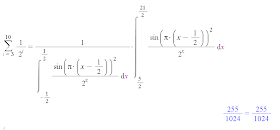The board is constructed as follows, a grid of wires runs across vertically and horizontally, but anywhere two lines intersect is insulated between the wires so they are not electrically connected.
A game piece is constructed like so:
The base of the piece is a square with four metal strips on the top and bottom and sides with insulation at the corners. And two resistors connect the top to the left side and the bottom to the right side.
For example let's say this piece had resistors both with values 1k ohms. It is placed on one of the black dots in the above game board.
Before the resistance between C and 3 was practically infinite because the wires were insulated from each other, but now the resistance between C and 3 is around 1k or the value of the game piece because electricity can travel from C to the game piece's metal strip and then across the 1k resistor and up to 3.
So if we make several types of game piece with resistances far apart, like say 1k 10k 100k 1000k, we can use algebra to determine where the pieces are on the game board even when there are multiple pieces and some are on the same vertical or horizontal row as long as the resistor values are far enough apart. For example maybe there are only 5 1k pieces, 6 10k, 7 100k, and 8 1000k. A computer could tell by checking the resistance between every pair of wires with one wire from the top and the corresponding wire from the left side where all of the pieces are on the game grid after solving some equations (simple for the computer).
** A game piece can also be constructed so that it uses two different resistors inside of it so the computer can solve for which way each piece is facing as well but then you would have to also check between bottom and right side wires**
the amount of electricity needed to read the resistances is pretty negligible, so it's not dangerous to have the game board wires exposed where they could accidentally be touched.
**EDIT**
Maybe the easiest way to implement this would be if each game piece had a spring loaded contact so you press down on each piece as you set them down and only that piece completes a circuit and only while you are pressing down and the computer keeps track of all their positions and type in memory. Then the computer doesn't have to solve any equations, it just checks horizontal wire/vertical wire pairs and captures when the value of the resistance goes from infinite to say 1k, and then it knows where the pressed game piece is and it's value. Also it would probably be better to have every piece in the whole set have a different resistance even if they are of the same type, so you can pick one up without pressing the switch and set it down somewhere and press and the computer would know from it's value exactly which one was moved.



















